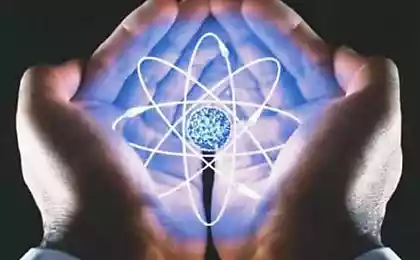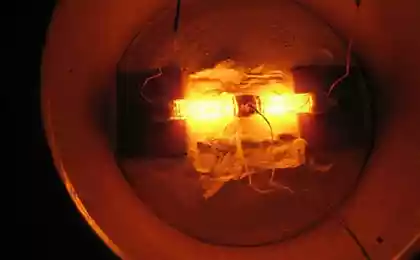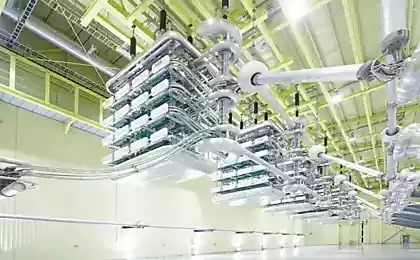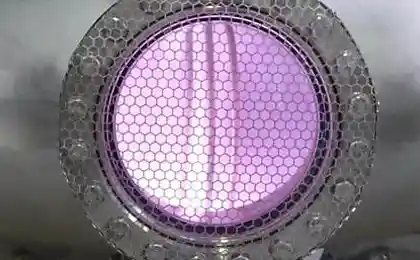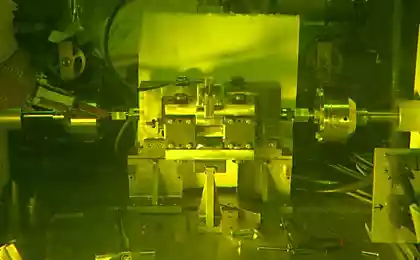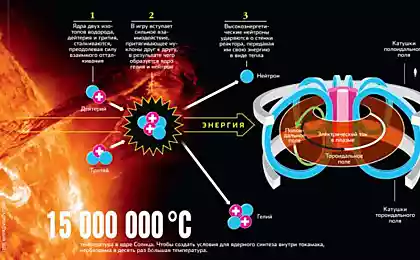1242
Fourth generation
Nuclear Power is deservedly considered one of the most conservative sectors, which reached the top of the way to its S-curve. The last 25 years outside observer would not have noticed a change in the key technology - the same assembly of the fuel elements, heat tracing or boil water, thermal energy conversion into electricity. More surprising fact that its future nuclear power sees the 6 revolutionary concepts, each of which in its paradigm shifts of nuclear energy in one direction or another.
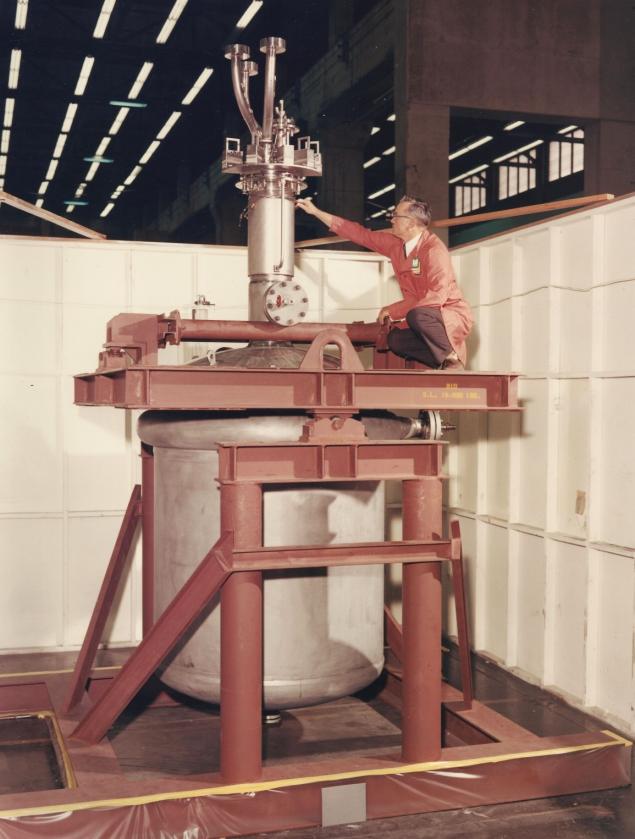
housing research reactor MSRE salts melt 70s
What is important is the fact that all of these concepts have arisen not today, but at the dawn of the birth of the nuclear industry and lost the competition for the title of industry standard reactors with pressurized water (PWR in Western terminology, or BBER in Russian). However, as in the case of electric vehicles, the gradual accumulation of technology can amount to return to the podium forgotten heroes of the dawn of the atomic age.
Fourth generation
The development of nuclear power from the beginning can be divided into 3, 5 unequal generation, where the first was marked by dozens of different concepts, sometimes very strange now look (like the British the Magnox - graphite-moderated reactors and circulating compressed carbon dioxide as a coolant), the second - two of the most severe accidents in the energy history, and the third and the third advantage - the prevalence of the financiers of the engineers. To date, the wonders and the enthusiasm of the atomic age gave way to the era when the improvement of operational nuclear power plant performance by 2-3 percent - a revolutionary advancement, widely discussed in the press profile
. The fourth generation must be a way out of the impasse in which was nuclear energy. To do this, you will need to resolve several contradictory problems - not to lose in the safety of the reactor, to improve or at least not to worsen its economy and solve the problem with the transition to the use of 235U to 238U
.
six concepts selected by the international organization Generation IV International Forum are trying to solve these problems from different angles. Who among them will be (and there will be) the basis for the development of the nuclear industry in the 21st century need to show research the next 15 years.
fast reactor with sodium
This type of reactor is sharply distinguished from the entire "team" of its flue and even some everyday. A key feature of this reactor is a fast neutron spectrum, which allows to realize a closed nuclear fuel cycle. However, this does not come for free, and two of the more complexity in such a reactor - fire hazard sodium and core damage structures with fast neutrons. However, in the 60s, at the time of the birth of nuclear power fast sodium saw the easiest on the way to closing the fuel cycle. A CNFC, in turn, seemed necessary to build thousands of reactors, which simply would not have enough reserves of uranium 235 isotope.

most "adult" and powerful representative of fast neutron reactors -. BN-800
As a result, BN type reactors have been the longest path (20 ever built and function) of the first pilot plant to full power - Phenix Superphenix and in France, the BN-600 in the USSR and the BN-800 in Russia. In the early 80s it seemed quite clear that by 2020 the world will have hundreds and thousands of gigawatt is fast neutron reactors. However, a sharp slowdown in the growth of nuclear power and a variety of circumstances - such as the arrival of "green" in the power of France, or the collapse of the Soviet Union broke off the takeoff. In France, by the way, from 1995 to 1998, functioned all elements CNFC - breeder plutonium fuel, spent fuel reprocessing plant and a plant for the fabrication of fresh fuel ...
58,046,139
device and features French not taken off Super Phenix
Today, the fast neutron reactors with an oxide or a denser fuel mixture of U238 and Pu239 frozen on the verge of what would begin to replace the reactors with water under pressure, and is widely included (5-10 blocks in the 10-15 year perspective and energy to the basics 30-50 years) in the development of plans for nuclear energy of the four countries, which have really develop - India, China, Russia and South Korea
.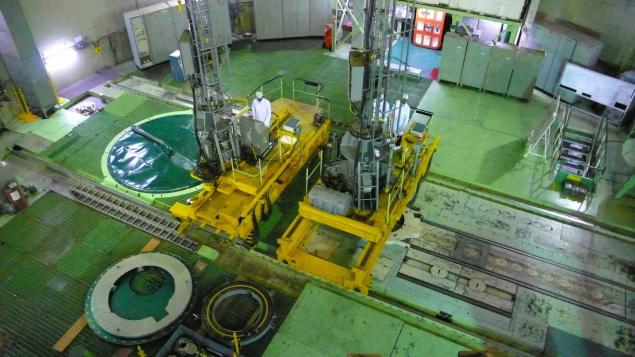
Reactor hall Indian sodium BR the FBR
Key installations in this area today yavlyutsya BN-600 and BN-800 in Russia, planned MBIR at us, and a pilot plant in India PFBR, ASTRID in France.
Quick lead reactor < /
In contrast to the previous reactors, heat transfer from the molten lead exist only on paper. This type invented in an attempt to overcome the problems Refresh - sodium fire risk (and related technical complexity - see details in the article about "Brest"), sodium boiling in AZ in accidents and the related risk of reactor runaway on prompt neutrons. Another "emergency" plus lead in the coolant is to maintain a particularly nasty volatile uranium fission products - cesium and iodine, and the screening of a nuclear fuel gamma
.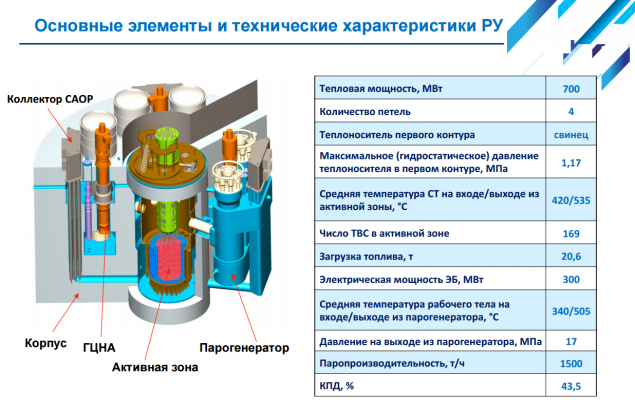
BREST-OD-300 - the most advanced in the world in the lead reactor project today
Of course, there are also disadvantages lead. The most important - the high melting temperature (327 C), and therefore great care to maintain the coolant in the molten state. There are also problems lead to corrosion of steel, poor compatibility with the oxide (the most common) fuel, well, in general, we can talk about a small elaboration of this type of reactors. Interestingly, on the basis of the idea of evolution sodium breeders in the USSR he was born quite a revolutionary project BREST, optimal for slow development of nuclear energy. Besides lead, the key there is the idea of charging fissile material once -. At the start, and then recharge only U238

A collage of photos of the process of development and testing of components of the BREST-OD-300. Such work takes thousands of man-years and cost billions of rubles.
Sometimes, in a cohort of lead added to lead-bismuth reactors. Adding bismuth coolant lowers its melting point to "sodium" values - about 100 C. The reactors with coolant as standard were placed on submarines 705 project, but in spite of proximity can not be transferred one technology to another
.
ALFRED reactor with lead coolant - the project is smaller and simpler BREST, but less technical risk
. BREST, along with European projects ALFRED today are the only "live" lead projects, available funding and the possibility of construction. In addition, there is created a Belgian MYRRHA reactor, lead-cooled, but this exotic and unique ADS system, where the neutron flux needed to work on the power source will be created accelerator. However, the real advantages and disadvantages of the lead reactors as compared to sodium is unlikely to be understood before 2030.
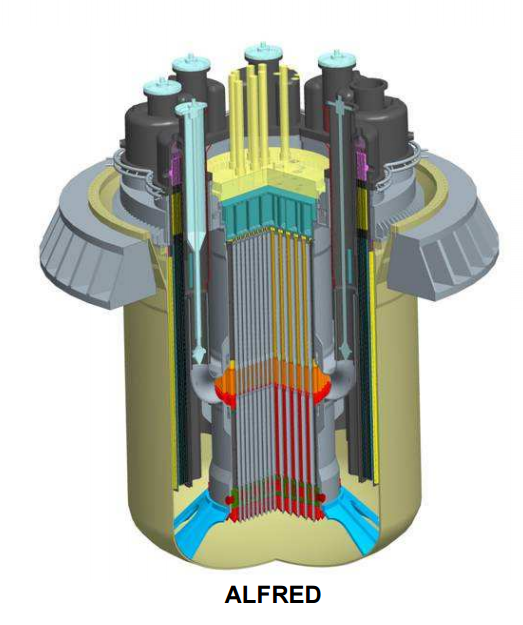
ALFRED planned for construction in the 20s.
Gas-Cooled Fast Reactor
Gas-cooled reactors of today - is the development of the Chinese branch of the German HTR. They have such a balanced set of pros and cons that the nuclear industry does not see the potential in their development but one which below. Gas reactors of the future must be different - breeders with a fast neutron spectrum (which, incidentally, is very trivial to the core with helium - a remarkable neutron moderator), cooled by inert helium, and produce electricity at the gas turbine
.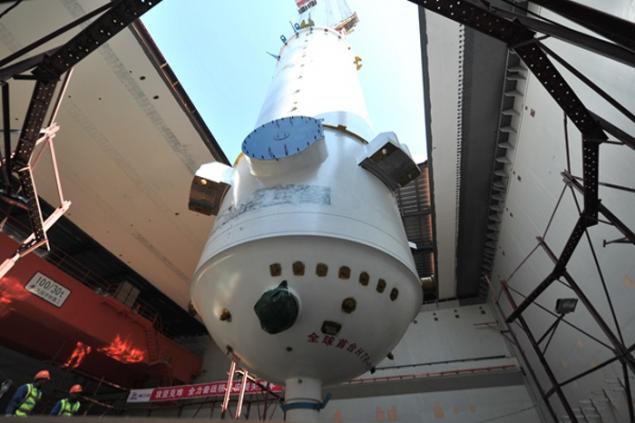
Installing new Chinese gas reactor vessel 3.25.2016
Today, gas cooled reactors have not received much development on a range of reasons, chief among them - at LOCA type accident (rupture of piping with a loss of tightness of the reactor) becomes nothing cool the core. What would you like something to deal with that, the heat in the event of an accident is withdrawn through the walls, and the size of AZ inflated to ten times compared to water-cooled reactors. In the IV generation of this problem will have to decide, and if it will make a "rapid gas" can tune entirely new colors, with their very high efficiency.


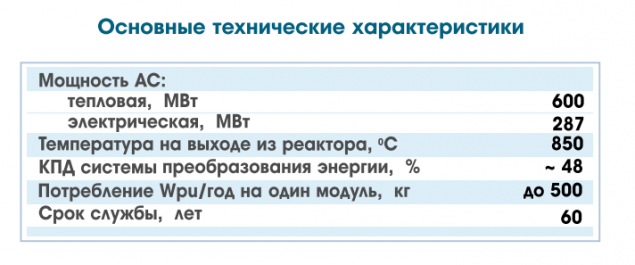
Project GT-MHR image with a gas turbine, gas turbine itself and the characteristics of the reactor facility. No steam generators.
Such single-circuit high-temperature approach, along with a completely different type of fuel (instead haytechnogo machine-building product that works with fuel in PWR / BWR / PWR offered something like sculpting million graphite bricks or pellets of uranium particles inside) theoretically allows to obtain very cheap nuclear energy. So far, however, far from it -. Easy to get a breeder helium-cooled and heat
An important advantage is further gas reactors inertia and inactivating helium used as a coolant. The downside is a significant energy costs for pumping helium through the reactor core.
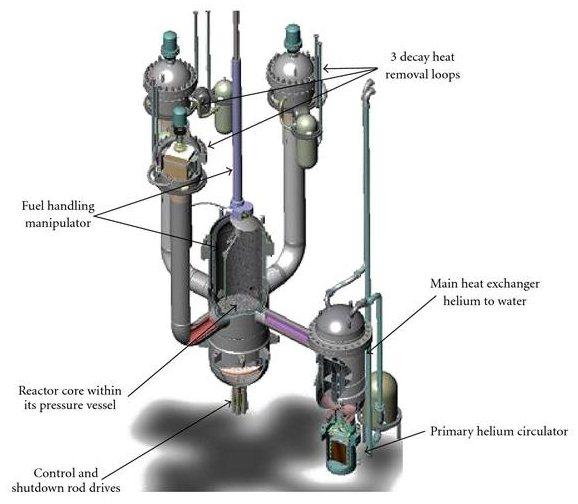
fast reactor gas-cooled the ALLEGRO
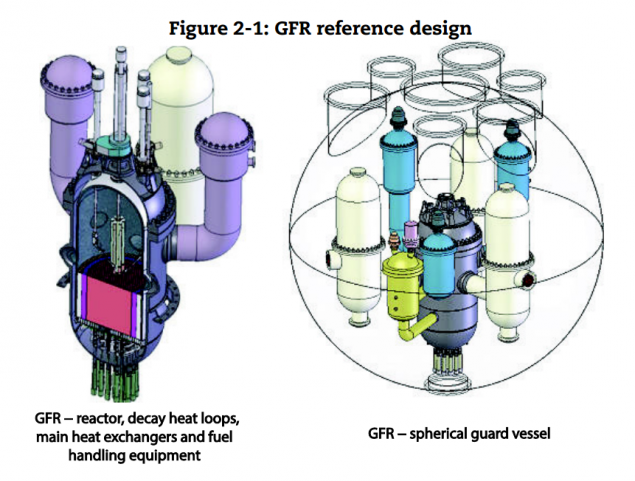
And promising a powerful gas-cooled fast reactor GFR. It is interesting to understand how there are going to cool the reactor fuel at the opening ...
At present, the only active project in this area is the European small research reactor, the ALLEGRO, the thermal capacity of 75 megawatts, using plutonium fuel. Its mission - to explore issues faced by designers of large (2400 MW thermal) long-term European gas breeder GFR. One of the most difficult - high temperature fuel and helium. You can also note the domestic project GT-MHR, once designed as an alternative to the BN-800.

And even a little bit of Chinese manufacturing HTR-PM. To the reactor vessel docked at this time the steam generator.
However, high temperature gas cooled reactors competition up ... gas-cooled reactors that exist today.
High-temperature gas reactor
The younger brother of the concept №3 whose main task - to be a source of nuclear heat for the chemical and metallurgical industries. For this purpose helium from the exhaust of the reactor should be heated to 900 degrees Celsius or higher. This area has got into the list of promising mainly due to a surge of interest in hydrogen energy in the 90s, when these installations had to produce hydrogen (hydrogen lot!) Of water pyrochemical means.
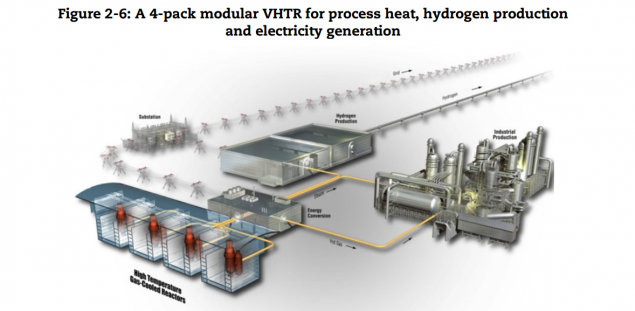
proposed station generating hydrogen using VGTR. Perhaps for future hydrogen energy future as energy storage systems for renewable energy dominance.
The main difference from the previous concept - that for a high temperature in HTGR fuel abandon breeding and CNFC. The technical basis for this type of gas cooled reactors are available from the filling ball (TRISO) or prismatic fuel. Japanese Research HTTR reactor, in particular helium temperature have been obtained 850 C.
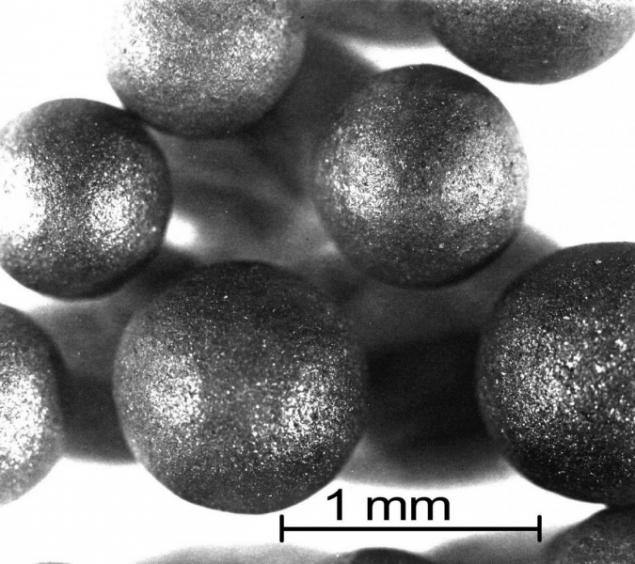
uranium microspheres dispersiruemye in graphite blocks - one of the fuel options for gas cooled reactors
However, not a lot of complexity (compared to other participants) with the implementation of the HTGR do favorite - along with the fading of interest in hydrogen energy, and lost the desire to invest in nuclear heat sources. Today, the only ones who develop this direction - the Chinese are building the first pilot HTR-PM industrial unit and have big plans for the development of this direction. However, perhaps, when the coal is too expensive or inconvenient for process heat, we will see the flowering of HTGR
Single-circuit reactor, supercritical water
At pressures above 225 atmospheres and temperatures above 374 degrees of water ceases to boil and turns into something between a liquid and vapor. If you take and try to "disperse" normal PWR / VVER coolant to such parameters, we can get a lot of unusual advantages
the most obvious - the efficiency of the installation will increase from 33% to 42-43% power will rise to 1, 5 times at about the same size and reactor cost less obvious -. due to the high heat capacity of the resulting coolant can increase the ratio of uranium to the water in the core and to receive intermediate reactor neutron spectrum to fuel ratio in reproduction in PP 0, 8-1, i.e. . Almost closed nuclear fuel cycle due to lack of boiling AZ much easier to get to do a single-reactor system - as in "Boilers" BWR, which still reduces the amount of equipment required to produce a full-fledged nuclear power plants li. >
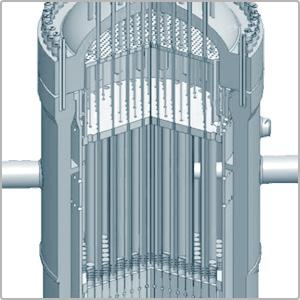
Structurally, such reactors do not differ much from the usual VVER, all the subtleties in the design of fuel
Moreover, in the thermal energy sector has a lot of experience to create steam power units for supercritical steam, ie problems as to create a gas turbine for gigawatt reactors gahoohlazhdaemyh not arise. He is playing into the hands of enormous experience and today's nuclear power development in the PWR / VVER.
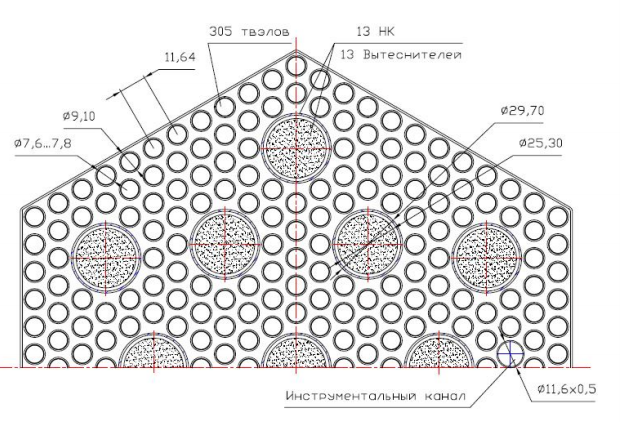
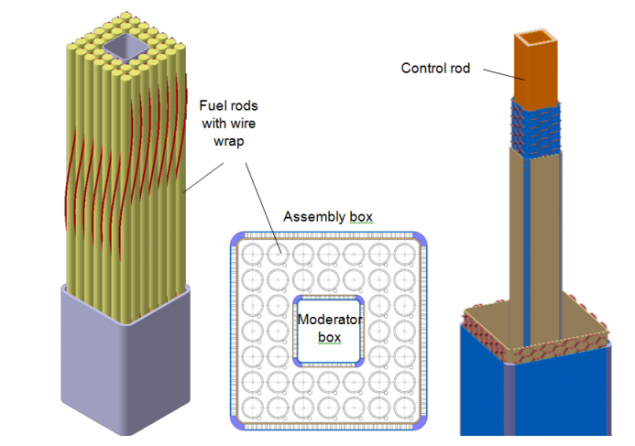
fuel for such reactors has cavities and channels for moving elements changing neutron moderation - spectrum reactor regulation
The main obstacle to the implementation of this direction is the aggressiveness of steam at a pressure of 250 atmospheres and a temperature of 560 degrees (which will be achieved in projects UDCWs), which means a large amount on the development of new materials and structures. It is not easy and the creation of the reactor vessel to such parameters, despite the fact that the efficiency of 43% promise fast reactors with metal coolants.
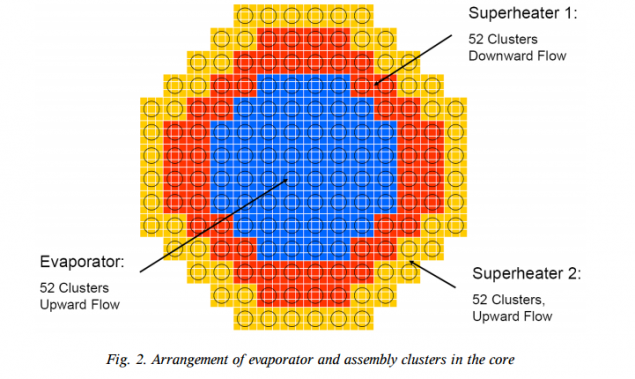
Americans also assumed a multiple pass coolant through the core.
Today the main investigation on the subject UDCWs go to Russia, Japan and the United States, which has created the VVER-SKD projects (link large review article) and Japanese SCFR and RMWR and American HPLWR - all yet fully the "paper»
. Molten salt reactor
The Holy Grail of nuclear energy, a place of worship of all reactors developers. The homogeneous mixture of molten beryllium fluoride / sodium fluoride and uranium / plutonium / thorium forms a liquid core, which is not afraid of problems of radiation resistance. Continuous selection and cleaning of the salt from the decay products (including neutron poisons) allows you to maintain the highest level of reproduction of fuel and automatically generates a closed nuclear fuel cycle right at the station. The reactor can easily be plugged, for example in the drain trap of the core where it is not critical. And the drain line can be plugged on during normal operation it freezes the plug from the fuel mixture, ie, in the case of loss of control and localization AZ stop automatically. The heat in this type of reactors must be removed through heat exchangers placed in the reactor vessel (integral type).

European projects MSR. Where other projects have complicated mechanics of the core, at the MSR quite Buddhist emptiness.
In addition MSR is the most convenient (along with heavy water) to engage in the thorium fuel cycle.
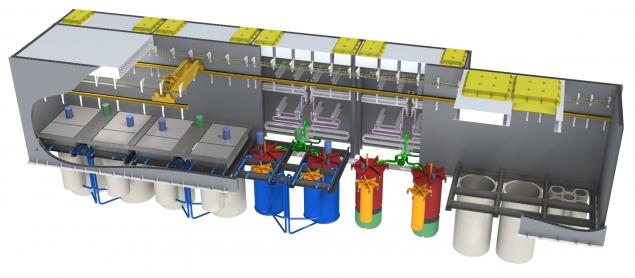
Besides serious guys from Gen 4 IF molten salt reactors are available for use and various startups
As usual, the advantages are also disadvantages. The absence of one of the barriers for the spread of radioactivity (cladding) raises questions in Atomnadzor. The constant presence of virtually all of the periodic table in the melt causes big problems with the corrosion resistance of the reactor vessel. The large radiochemical plant next to the reactor in addition to again issues radiofobskih creates even with the non-proliferation of nuclear materials problems. After MSR is not just a manufacturer of weapons - but it is better than weapons-grade plutonium in a very tangible scale. In fact, such a nuclear power plant can produce weapons-grade material for dozens of nuclear bombs per year.
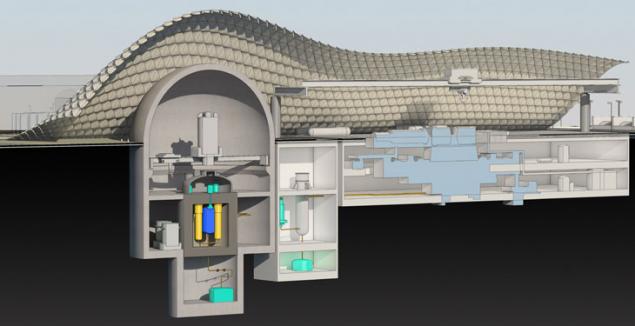
Another MSR from start Transatomic Power. referring to zhidkosolevikam frequency startups alarming.
In the 20th century two small molten-salt reactors operated in US - Aircraft Reactor Experiment (ARE) and the Molten Salt Reactor Experiment (MSRE), and only the second of which was successful, and considered to have been closed in 1976 in favor of a much more successful (and something more simple) fast reactor with sodium coolant. (An interesting documentary, in English about MSRE)
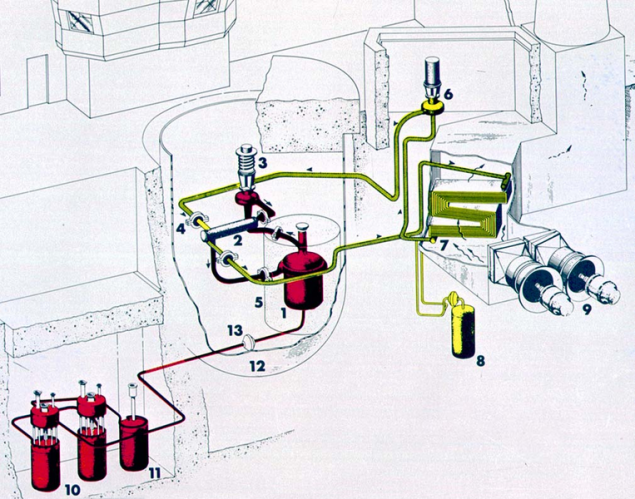
reactor MSRE. Here 1 - reactor, 2 - heat exchanger circuits 1-2, 3, 6 - tsikrulyatsionnye pumps 7, 8, 9 - heat removal from the reactor system is in the air, 10, 11 - drain the tanks of salt melt, 13 - is frozen for emergency drain tube salt.
Сегодня, не смотря на регулярно возникающий интерес к этому “идеальному ядерному реактору”, нет ни одного поддержанного финансированием проекта по строительство хотя бы исследовательской установки. Разрабатываются только “бумажные” реакторы, например MOSART или MSFR или проекты стартапов. Однако потенциальная перспективность заставляет проводить разнообразные поддерживающие исследования (например по коррозионной стойкости) в надежде, что когда-нибудь прогресс в других областях (например в материалах) даст толчок развитию ЖСР.
Заключение
Если бы в мире вновь возник стойкий интерес к атомной энергии, то у индустрии в загашнике есть разработки способные решить множество задач по устойчивому обеспечению энергией цивилизации. Однако в условиях, когда все плюшки достаются возобновляемым источником скорее всего по большинству из перспективных концепций реакторов мы увидим только опытные установки и неспешное их развитие.
Источник: geektimes.ru/post/274064/

housing research reactor MSRE salts melt 70s
What is important is the fact that all of these concepts have arisen not today, but at the dawn of the birth of the nuclear industry and lost the competition for the title of industry standard reactors with pressurized water (PWR in Western terminology, or BBER in Russian). However, as in the case of electric vehicles, the gradual accumulation of technology can amount to return to the podium forgotten heroes of the dawn of the atomic age.
Fourth generation
The development of nuclear power from the beginning can be divided into 3, 5 unequal generation, where the first was marked by dozens of different concepts, sometimes very strange now look (like the British the Magnox - graphite-moderated reactors and circulating compressed carbon dioxide as a coolant), the second - two of the most severe accidents in the energy history, and the third and the third advantage - the prevalence of the financiers of the engineers. To date, the wonders and the enthusiasm of the atomic age gave way to the era when the improvement of operational nuclear power plant performance by 2-3 percent - a revolutionary advancement, widely discussed in the press profile
. The fourth generation must be a way out of the impasse in which was nuclear energy. To do this, you will need to resolve several contradictory problems - not to lose in the safety of the reactor, to improve or at least not to worsen its economy and solve the problem with the transition to the use of 235U to 238U
.

six concepts selected by the international organization Generation IV International Forum are trying to solve these problems from different angles. Who among them will be (and there will be) the basis for the development of the nuclear industry in the 21st century need to show research the next 15 years.
fast reactor with sodium
This type of reactor is sharply distinguished from the entire "team" of its flue and even some everyday. A key feature of this reactor is a fast neutron spectrum, which allows to realize a closed nuclear fuel cycle. However, this does not come for free, and two of the more complexity in such a reactor - fire hazard sodium and core damage structures with fast neutrons. However, in the 60s, at the time of the birth of nuclear power fast sodium saw the easiest on the way to closing the fuel cycle. A CNFC, in turn, seemed necessary to build thousands of reactors, which simply would not have enough reserves of uranium 235 isotope.

most "adult" and powerful representative of fast neutron reactors -. BN-800
As a result, BN type reactors have been the longest path (20 ever built and function) of the first pilot plant to full power - Phenix Superphenix and in France, the BN-600 in the USSR and the BN-800 in Russia. In the early 80s it seemed quite clear that by 2020 the world will have hundreds and thousands of gigawatt is fast neutron reactors. However, a sharp slowdown in the growth of nuclear power and a variety of circumstances - such as the arrival of "green" in the power of France, or the collapse of the Soviet Union broke off the takeoff. In France, by the way, from 1995 to 1998, functioned all elements CNFC - breeder plutonium fuel, spent fuel reprocessing plant and a plant for the fabrication of fresh fuel ...
58,046,139
device and features French not taken off Super Phenix
Today, the fast neutron reactors with an oxide or a denser fuel mixture of U238 and Pu239 frozen on the verge of what would begin to replace the reactors with water under pressure, and is widely included (5-10 blocks in the 10-15 year perspective and energy to the basics 30-50 years) in the development of plans for nuclear energy of the four countries, which have really develop - India, China, Russia and South Korea
.

Reactor hall Indian sodium BR the FBR
Key installations in this area today yavlyutsya BN-600 and BN-800 in Russia, planned MBIR at us, and a pilot plant in India PFBR, ASTRID in France.
Quick lead reactor < /
In contrast to the previous reactors, heat transfer from the molten lead exist only on paper. This type invented in an attempt to overcome the problems Refresh - sodium fire risk (and related technical complexity - see details in the article about "Brest"), sodium boiling in AZ in accidents and the related risk of reactor runaway on prompt neutrons. Another "emergency" plus lead in the coolant is to maintain a particularly nasty volatile uranium fission products - cesium and iodine, and the screening of a nuclear fuel gamma
.

BREST-OD-300 - the most advanced in the world in the lead reactor project today
Of course, there are also disadvantages lead. The most important - the high melting temperature (327 C), and therefore great care to maintain the coolant in the molten state. There are also problems lead to corrosion of steel, poor compatibility with the oxide (the most common) fuel, well, in general, we can talk about a small elaboration of this type of reactors. Interestingly, on the basis of the idea of evolution sodium breeders in the USSR he was born quite a revolutionary project BREST, optimal for slow development of nuclear energy. Besides lead, the key there is the idea of charging fissile material once -. At the start, and then recharge only U238

A collage of photos of the process of development and testing of components of the BREST-OD-300. Such work takes thousands of man-years and cost billions of rubles.
Sometimes, in a cohort of lead added to lead-bismuth reactors. Adding bismuth coolant lowers its melting point to "sodium" values - about 100 C. The reactors with coolant as standard were placed on submarines 705 project, but in spite of proximity can not be transferred one technology to another
.

ALFRED reactor with lead coolant - the project is smaller and simpler BREST, but less technical risk
. BREST, along with European projects ALFRED today are the only "live" lead projects, available funding and the possibility of construction. In addition, there is created a Belgian MYRRHA reactor, lead-cooled, but this exotic and unique ADS system, where the neutron flux needed to work on the power source will be created accelerator. However, the real advantages and disadvantages of the lead reactors as compared to sodium is unlikely to be understood before 2030.

ALFRED planned for construction in the 20s.
Gas-Cooled Fast Reactor
Gas-cooled reactors of today - is the development of the Chinese branch of the German HTR. They have such a balanced set of pros and cons that the nuclear industry does not see the potential in their development but one which below. Gas reactors of the future must be different - breeders with a fast neutron spectrum (which, incidentally, is very trivial to the core with helium - a remarkable neutron moderator), cooled by inert helium, and produce electricity at the gas turbine
.

Installing new Chinese gas reactor vessel 3.25.2016
Today, gas cooled reactors have not received much development on a range of reasons, chief among them - at LOCA type accident (rupture of piping with a loss of tightness of the reactor) becomes nothing cool the core. What would you like something to deal with that, the heat in the event of an accident is withdrawn through the walls, and the size of AZ inflated to ten times compared to water-cooled reactors. In the IV generation of this problem will have to decide, and if it will make a "rapid gas" can tune entirely new colors, with their very high efficiency.



Project GT-MHR image with a gas turbine, gas turbine itself and the characteristics of the reactor facility. No steam generators.
Such single-circuit high-temperature approach, along with a completely different type of fuel (instead haytechnogo machine-building product that works with fuel in PWR / BWR / PWR offered something like sculpting million graphite bricks or pellets of uranium particles inside) theoretically allows to obtain very cheap nuclear energy. So far, however, far from it -. Easy to get a breeder helium-cooled and heat
An important advantage is further gas reactors inertia and inactivating helium used as a coolant. The downside is a significant energy costs for pumping helium through the reactor core.

fast reactor gas-cooled the ALLEGRO

And promising a powerful gas-cooled fast reactor GFR. It is interesting to understand how there are going to cool the reactor fuel at the opening ...
At present, the only active project in this area is the European small research reactor, the ALLEGRO, the thermal capacity of 75 megawatts, using plutonium fuel. Its mission - to explore issues faced by designers of large (2400 MW thermal) long-term European gas breeder GFR. One of the most difficult - high temperature fuel and helium. You can also note the domestic project GT-MHR, once designed as an alternative to the BN-800.

And even a little bit of Chinese manufacturing HTR-PM. To the reactor vessel docked at this time the steam generator.
However, high temperature gas cooled reactors competition up ... gas-cooled reactors that exist today.
High-temperature gas reactor
The younger brother of the concept №3 whose main task - to be a source of nuclear heat for the chemical and metallurgical industries. For this purpose helium from the exhaust of the reactor should be heated to 900 degrees Celsius or higher. This area has got into the list of promising mainly due to a surge of interest in hydrogen energy in the 90s, when these installations had to produce hydrogen (hydrogen lot!) Of water pyrochemical means.

proposed station generating hydrogen using VGTR. Perhaps for future hydrogen energy future as energy storage systems for renewable energy dominance.
The main difference from the previous concept - that for a high temperature in HTGR fuel abandon breeding and CNFC. The technical basis for this type of gas cooled reactors are available from the filling ball (TRISO) or prismatic fuel. Japanese Research HTTR reactor, in particular helium temperature have been obtained 850 C.

uranium microspheres dispersiruemye in graphite blocks - one of the fuel options for gas cooled reactors
However, not a lot of complexity (compared to other participants) with the implementation of the HTGR do favorite - along with the fading of interest in hydrogen energy, and lost the desire to invest in nuclear heat sources. Today, the only ones who develop this direction - the Chinese are building the first pilot HTR-PM industrial unit and have big plans for the development of this direction. However, perhaps, when the coal is too expensive or inconvenient for process heat, we will see the flowering of HTGR
Single-circuit reactor, supercritical water
At pressures above 225 atmospheres and temperatures above 374 degrees of water ceases to boil and turns into something between a liquid and vapor. If you take and try to "disperse" normal PWR / VVER coolant to such parameters, we can get a lot of unusual advantages
the most obvious - the efficiency of the installation will increase from 33% to 42-43% power will rise to 1, 5 times at about the same size and reactor cost less obvious -. due to the high heat capacity of the resulting coolant can increase the ratio of uranium to the water in the core and to receive intermediate reactor neutron spectrum to fuel ratio in reproduction in PP 0, 8-1, i.e. . Almost closed nuclear fuel cycle due to lack of boiling AZ much easier to get to do a single-reactor system - as in "Boilers" BWR, which still reduces the amount of equipment required to produce a full-fledged nuclear power plants li. >

Structurally, such reactors do not differ much from the usual VVER, all the subtleties in the design of fuel
Moreover, in the thermal energy sector has a lot of experience to create steam power units for supercritical steam, ie problems as to create a gas turbine for gigawatt reactors gahoohlazhdaemyh not arise. He is playing into the hands of enormous experience and today's nuclear power development in the PWR / VVER.


fuel for such reactors has cavities and channels for moving elements changing neutron moderation - spectrum reactor regulation
The main obstacle to the implementation of this direction is the aggressiveness of steam at a pressure of 250 atmospheres and a temperature of 560 degrees (which will be achieved in projects UDCWs), which means a large amount on the development of new materials and structures. It is not easy and the creation of the reactor vessel to such parameters, despite the fact that the efficiency of 43% promise fast reactors with metal coolants.

Americans also assumed a multiple pass coolant through the core.
Today the main investigation on the subject UDCWs go to Russia, Japan and the United States, which has created the VVER-SKD projects (link large review article) and Japanese SCFR and RMWR and American HPLWR - all yet fully the "paper»
. Molten salt reactor
The Holy Grail of nuclear energy, a place of worship of all reactors developers. The homogeneous mixture of molten beryllium fluoride / sodium fluoride and uranium / plutonium / thorium forms a liquid core, which is not afraid of problems of radiation resistance. Continuous selection and cleaning of the salt from the decay products (including neutron poisons) allows you to maintain the highest level of reproduction of fuel and automatically generates a closed nuclear fuel cycle right at the station. The reactor can easily be plugged, for example in the drain trap of the core where it is not critical. And the drain line can be plugged on during normal operation it freezes the plug from the fuel mixture, ie, in the case of loss of control and localization AZ stop automatically. The heat in this type of reactors must be removed through heat exchangers placed in the reactor vessel (integral type).

European projects MSR. Where other projects have complicated mechanics of the core, at the MSR quite Buddhist emptiness.
In addition MSR is the most convenient (along with heavy water) to engage in the thorium fuel cycle.

Besides serious guys from Gen 4 IF molten salt reactors are available for use and various startups
As usual, the advantages are also disadvantages. The absence of one of the barriers for the spread of radioactivity (cladding) raises questions in Atomnadzor. The constant presence of virtually all of the periodic table in the melt causes big problems with the corrosion resistance of the reactor vessel. The large radiochemical plant next to the reactor in addition to again issues radiofobskih creates even with the non-proliferation of nuclear materials problems. After MSR is not just a manufacturer of weapons - but it is better than weapons-grade plutonium in a very tangible scale. In fact, such a nuclear power plant can produce weapons-grade material for dozens of nuclear bombs per year.

Another MSR from start Transatomic Power. referring to zhidkosolevikam frequency startups alarming.
In the 20th century two small molten-salt reactors operated in US - Aircraft Reactor Experiment (ARE) and the Molten Salt Reactor Experiment (MSRE), and only the second of which was successful, and considered to have been closed in 1976 in favor of a much more successful (and something more simple) fast reactor with sodium coolant. (An interesting documentary, in English about MSRE)

reactor MSRE. Here 1 - reactor, 2 - heat exchanger circuits 1-2, 3, 6 - tsikrulyatsionnye pumps 7, 8, 9 - heat removal from the reactor system is in the air, 10, 11 - drain the tanks of salt melt, 13 - is frozen for emergency drain tube salt.
Сегодня, не смотря на регулярно возникающий интерес к этому “идеальному ядерному реактору”, нет ни одного поддержанного финансированием проекта по строительство хотя бы исследовательской установки. Разрабатываются только “бумажные” реакторы, например MOSART или MSFR или проекты стартапов. Однако потенциальная перспективность заставляет проводить разнообразные поддерживающие исследования (например по коррозионной стойкости) в надежде, что когда-нибудь прогресс в других областях (например в материалах) даст толчок развитию ЖСР.
Заключение
Если бы в мире вновь возник стойкий интерес к атомной энергии, то у индустрии в загашнике есть разработки способные решить множество задач по устойчивому обеспечению энергией цивилизации. Однако в условиях, когда все плюшки достаются возобновляемым источником скорее всего по большинству из перспективных концепций реакторов мы увидим только опытные установки и неспешное их развитие.
Источник: geektimes.ru/post/274064/
Jet Pack International Vice President crashed on jetpacks (alive, stable condition)
Reuse in May-June: results SpaceX CRS-8


